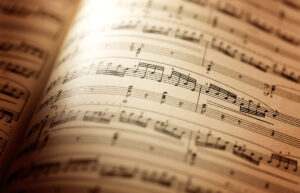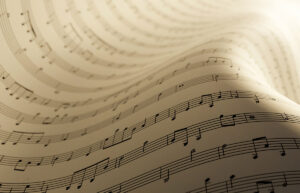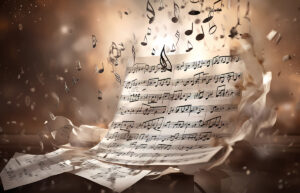How to Read Piano Sheet Music- A Step-by-Step Guide 2023

Master the world of Piano Sheet Music with this comprehensive manual. This guide covers everything from understanding its significance to decoding every element, note, and clef. Gain confidence in your skills as you progress from basics to advanced techniques. Everything you need is right here in this manual.
Welcome to TheDemoStop, now join the community!
Connect with artists, fans and producers around the world.
What is piano sheet music?
Piano Sheet Music is a written or printed musical notation specifically designed for piano. It uses a set of symbols and markings to represent the pitch, rhythm, and expression of a piece of music, which allows pianists to interpret and perform it accurately.
Importance of learning to read piano sheet music
Playing well with others
If an individual ever plans on playing the instrument with others, it is extremely crucial to know how to read a Piano Sheet Music in order to be in sync with the others and avoid any sort of confusion amongst the other instrumentalists. This not only helps with the timing but enhances the overall outcome of the performance.
Boosting brain power
Mastering the art of reading music helps enhance craft and sharpens analytical and mathematical abilities. When one learns to read notes and chords, their memory gets better, and they start to fully comprehend music theory.
Becoming a more diverse musician
Learning to read sheet music allows individuals to pick up various instruments more swiftly than those without this skill. Moreover, it extends beyond instruments, encompassing diverse music genres such as jazz, country, and classical music. Proficiency in reading sheet music also acquaints individuals with a broad spectrum of techniques, enhancing their abilities as composers.
Key signature of piano sheet music
In music, the key signature is represented by one or more flats (b) or sharps (#), known as accidentals (the exception being C Major, which has no accidentals). The statement of the actual key in the notation system appears at the beginning of a written music piece on music sheets. The key signature includes symbols for flats and sharps near the clefs.
List of all keys with accidentals
Following is the list of all the keys with accidentals-
C — Nor flats or sharps.
G — One sharp.
D — Two sharps.
A — Three sharps.
E — Four sharps.
B — Five sharps.
F# — Six sharps.
C# — Seven sharps.
F — One flat.
Bb — Two flats.
Eb — Three flats.
Ab — Four flats.
Db — Five flats.
Gb — Six flats.
G# — Because of a double sharp, it is normally not used.
D# — It is normally not used because of two double sharps.
A# — Because of three double sharps, it is normally not used.
It’s of help to know that when keys are indicated, the sharps and flats are always in the same order:
Sharps — F#, C#, G#, D#, A#, E#, B#
Flats — Bb, Eb, Ab, Db, Gb, Cb, Fb
Minor key signatures
Minor key signatures in piano sheet music indicate the key in which a piece is written in a minor key. Here’s a summary of minor key signatures:
Natural Minor Key Signatures: No sharps or flats.
A Minor
E Minor
B Minor
F♯ Minor
C♯ Minor
G♯ Minor
D♯ Minor
Harmonic Minor Key Signatures:
A Minor: G♯ (raises the seventh note).
E Minor: D♯ (raises the seventh note).
B Minor: D♯ (raises the seventh note).
F♯ Minor: D♯ (raises the seventh note).
C♯ Minor: D♯ (raises the seventh note).
G♯ Minor: D♯ (raises the seventh note).
D♯ Minor: C♯, G♯ (raises the sixth and seventh notes).
Melodic Minor Key Signatures: On the way up, no sharps or flats on the way down.
A Minor: G♯ (raises the seventh note)
E Minor: D♯ (raises the seventh note)
B Minor: D♯, A♯ (raises the sixth and seventh notes)
F♯ Minor: D♯ (raises the seventh note)
C♯ Minor: D♯, G♯ (raises the sixth and seventh notes)
G♯ Minor: D♯, A♯ (raises the sixth and seventh notes)
D♯ Minor: C♯, G♯ (raises the sixth and seventh notes)
These key signatures help musicians understand which notes are altered in a consistent manner throughout a piece in a minor key.
Welcome to TheDemoStop, now join the community!
Connect with artists, fans and producers around the world.
7 Basic components of piano sheet music
To master the skill of reading Piano Sheet Music, it’s crucial to familiarize yourself with its seven fundamental components: The Staff, Clefs, Time Signature, Piano Notes, Accidentals, and Dynamic Markings.
Staff

Musical notation starts with a five-line staff. The lines and spaces on it represent different notes, and the notes change with the type of clef used. Bar lines that go across the staff separate musical measures. Some of the bar lines in musical notation include:
- Single Bar Lines- They distinguish between each musical measure.
- Double Bar Lines- They separate sections within a musical piece.
- Bold Double Bar Lines- They signify the end of a musical movement or an entire piece.
Clefs

The lines and spaces of the treble clef (or other clefs like the alto clef and tenor clef) represent distinct notes from the lines and spaces of the bass clef. The three main musical clefs are as follows:
- Treble Clef- This clef is also known as the “G clef” because the inner curl of the letter G, which surrounds the line representing the note G, is used to represent it. The right hand commonly plays notes on the treble clef in piano sheet music.
- Bass Clef- This clef is also known as the “F clef” because it resembles the letter “F” and has dots that are evenly spaced along the line designating the note “F.” Normally, the left-hand plays notes from the bass clef in piano sheet music.
Notes

The length of musical notes varies. Note values of various lengths are represented in different ways when they are written in sheet music.
- Whole Note- A single note spanning a complete four-beat measure is called a Whole Note. It has an unstamped open notehead.
- Half Note- A single note that spans half of a four-beat measure. It includes a stemmed open notehead.
- Quarter Note- One note or quarter note makes up one-fourth of a four-bat measure. It has a stemmed, closed notehead.
- Eighth note- One-eighth of a four-beat measure is represented by an eighth note. A closed notehead with a stem and a tail is present.
- Sixteenth Note- One-sixteenth of a four-beat measure is represented by a sixteenth note. It has a twin tail and a closed notehead with a stem.
Although some types of music have even smaller subdivisions (32nd notes, 64th notes, and occasionally 128th notes appear in written music), composers usually use tempos that do not require such brief durations.
Accidentals


Accidentals like flats and sharps can be found in musical notes and add extra information. Western music’s 12 notes can be found on a five-line musical staff. The primary accidentals are:
- Sharp- This marking instructs the musician to play a note on half step above the pitch on the staff.
- Flat- This marking instructs the musician to play a note on half step below the pitch on the staff.
- Double Sharp- The notation instructs the musician to play a note one complete step higher than the pitch indicated on the staff.
- Double Flat- This marking instructs the musician to play a note one complete step below the pitch written on the staff.
- Natural- This symbol tells the musician to ignore any accidentals that have already been stated and to just play the pitch that is written on the staff.
Time Signatures

In music notation, the rhythmic duration is represented. Western music’s rhythm is primarily determined by the time signature and tempo, which jointly define the duration and division of each musical measure. The musical time signature indicates both the length of each beat in a measure and the number of beats per measure.
Musicians use specific numbers to instruct how to count the beats. The most common one is akin to saying, “1, 2, 3, 4” repeatedly, known as “common time,” denoted by a big “C” or 4/4. Another example is like saying, “1, 2, 3” in a loop, represented as 3/4, signifying three beats in a measure. Think of tapping your foot along with a song—those taps align with the beats. There’s also 6/8, which resembles saying, “1, 2, 3, 4, 5, 6.” Hence, these numbers assist musicians in maintaining the rhythm and ensuring everyone stays in harmony.
Notes
Western music uses the following twelve notes:
- C
- C♯ / D♭
- D
- D♯ / E♭
- E
- F
- F♯ / G♭
- G
- G♯ / A♭
- A
- A♯ / B♭
- B
Both note designations create the same pitch when two notes are specified (for example, C/D). Depending on the key signature, the note’s name changes. For instance, note C appears in the A major scale; however, the same pitch appears in the B minor scale under the name D.
The 12 notes from C4 to C5 are depicted on the treble clef using sharps as opposed to flats. The 12 notes are depicted on the bass clef using flats rather than sharps as they descend from C4 to C3.
Dynamic Markings
Instructions on how to play the piece can be found in the sheet music notation. Dynamic marks on piano sheet music typically instruct a performer how loudly or quietly to play the music on the page. Bowing instructions are often included in the notation of string music. The key to studying music is to comprehend these signs.
Welcome to TheDemoStop, now join the community!
Connect with artists, fans and producers around the world.
Why should you learn to read music?
Learning to read music is like learning the language of musicians. It allows a person to understand and play various musical pieces, communicate with other musicians, and express oneself creatively through the universal language of notes and rhythms.
It’s quicker than you think
Contrary to popular belief, learning to read music takes less time than one might think. While the notations may seem confusing at first, it becomes much easier and more intuitive once you get the hang of it. It’s a straightforward process, but it does necessitate consistent and structured practice to become proficient in reading the new notations.
Sight reading
Sight reading is essentially the skill of being able to play a piece of music for the first time just by reading it, much like reading a sentence aloud from a piece of paper. While it does take some time and a considerable amount of practice, after putting in the effort, it becomes much easier to take written music and play it instantly. Once someone learns to sight read, they can tackle virtually any piece of music, especially with the abundance of sheet music available on the internet.
Reading removes doubt
Over time, our “musical ear” gradually grows. However, mastering the ability to recognize notes, intervals, and chords by ear requires training. Even pianists who have spent years honing their ears will occasionally struggle with this formidable skill. Finding a single note or a quick series of notes might be particularly challenging.
Let’s say a person enjoys a song and wants to learn how to play it. If they cannot read music, they will need to slow it down, play it repeatedly, and still be dubious of their understanding. If they read the music, they will immediately be able to play along since they will be aware of the notes and how they should be played.
A permanent memory aid
To play by ear, one must retain all of the information they have ever chosen to learn. Written music serves as a record of everything they have learned and everything they intend to study. One can create their own notation if they do not have a great memory, but since there’s already a universal language, it should be fine.
No boundaries
The beauty of this is that there is no limit to what and how one can play a song. Knowing the composed version of the music does not mean one cannot play it uniquely. There’s freedom to break the rules, whichever suits the player, because it gives a personal touch to the music.
Steps of reading piano sheet music
It may seem difficult to learn how to read music notes, but it’s easier than one may imagine. All one needs to do is familiarize oneself with the names of the lines and spaces on the musical staff, comprehend note values, and then figure out how the symbols on the page correspond to their right and left hands on the keyboard. The only thing left is practice, beginning with easy piano sheet music.
Often, it’s difficult to learn how to read sheet music, but at the same time it’s crucial to do so. Following are some basics:
- For many musical instruments, the ability to read sheet music is crucial.
- One must put in the necessary effort, practice, and time to learn how to read sheet music.
- On sheet music, several symbols represent notes, chords, rhythm, dynamics, and more.
- A person who does their homework, takes lessons, and practices frequently can become a proficient reader of sheet music.
Step 1: Learn the basic symbols of musical notations
The staff, clefs, and notes are the most fundamental musical symbols. However, there are many others. These essential elements can be found in all music; thus, becoming familiar with them is necessary for learning how to read music.
- The Staff- Picture a musical staff like a ladder with five steps and some spaces in between. Now, each step and each space is like a special spot for musical notes. These notes are like friends with names from A to G. When one plays a piece, they climb up the musical ladder, meeting different notes in order, just like saying the alphabet. So, reading music is a bit like going on a musical adventure where each step or space brings a new note and sound.
- Treble Clef- Imagine two special symbols in music, like their own secret codes. The first one is called a treble clef—it looks like a fancy “G.” This G wraps around a special line on the musical ladder. When one sees this treble clef, it’s like a sign that the music will have higher sounds. So, if they play an instrument that makes high-pitched sounds, like a flute or violin, or if they play the higher keys on a piano, their music will probably have this treble clef.
- Bass Clef- Now, let’s talk about another musical symbol called the bass clef—it looks like a fancy backward “C” with two dots. There’s a special line between those dots called the “F” line. This bass clef is like a sign that tells that the music will have lower sounds. So, if one plays an instrument that makes lower-pitched sounds, like a tuba or cello, or if they’re playing the lower keys on a piano, their music will likely have this bass clef! It’s like a musical code for the lower notes.
Step 2: Learn to interpret the staff
The canvas on which musical notes are inscribed is known as the Musical Staff. It comprises four spaces and five horizontal lines. These lines and gaps serve as a guide for the varied pitches in music. Lower pitches find their place on the lower lines and spaces, while higher pitches are located on the higher lines and spaces. This arrangement forms the foundation for reading and interpreting sheet music.
Step 3: Understanding the rhythm and timing in piano
Timing and rhythm are important in music. They specify when and how long to play the notes. The note values and the time signature both show this. Both the note values (whole, half, quarter, eighth, and sixteenth) and the time signature indicate how many beats are contained in each measure. Of course, using some blank piano sheet music can help one practice writing all the notes one learns.
Step 4: Pick up the beat
Knowing a song’s meter, or the beat one uses when clapping, tapping the foot, or dancing to it, is a requirement for playing music. The meter is given as a fraction while reading music with a top number and a bottom number. This is the time signature of the song. The top number indicates the number of beats, or the distance between each vertical line (also known as a bar), in a measure. The note value (the length) of each beat is shown by the bottom number.
Step 5: Play a melody on the piano
It’s time to put it all together and perform a song once an individual has a handle on the symbols and rhythm. One can start off with a straightforward melody that just requires a few notes. Gradually advance to more challenging pieces as they become more comfortable. Always remember that practice is essential. One can get better at reading and playing sheet music as they practice more.
Welcome to TheDemoStop, now join the community!
Connect with artists, fans and producers around the world.
7 Practice tips to reading piano sheet music
Reading Sheet Music is often difficult to learn at first, but one can get better each day with regular practice and dedication. The knowledge of reading sheet music gives one the confidence to play whatever music comes their way at any given moment. Here are a few practice tips to learn how to read piano sheet music:
Know the basic
Start by studying notes and scales. Scales will aid in one’s note-reading development and increase their familiarity with the many names for these scales. Learn a major scale first and grasp why each note has a particular name. Spend some time learning the various notation symbols available, which can be fairly intimidating at first but get much simpler with practice. Once an individual has mastered this, they can graduate to more advanced scales and learn how to read harder sheet music.
Get familiar with variety of rhythms
To excel in music, it’s essential to recognize various rhythms and their characteristics. Developing a keen sense of time and understanding the distinctions between long, short, quarter, and eighth notes are two effective ways to achieve this. Familiarize yourself with how these rhythms are represented on sheet music.
Additionally, there are numerous online resources, such as Music Notes, where you can find excellent sheet music for any instrument. Finding books on sheet music is relatively easy, too. Search for them, and you can easily learn through these resources. This comprehensive approach will greatly enhance your proficiency in reading and playing sheet music.
Learning about the starting and resting position
Knowing this is crucial since it will make it easier for an individual to identify which pitches and symbols are placed where on the sheet music. Learn about stems and flags first. Flags denote dotted rests, while stems are seen with notes and rest. Maintaining a steady beat is essential while reading sheet music, so focusing on their sense of timing will be very beneficial here. They can have a little break and some time to prepare for the next set when they are in the starting and resting positions.
Break it down into smaller chunks
It can be incredibly intimidating to start reading music when learning a new instrument. Break things down into smaller, more manageable bits rather than worrying about them all at once. Before learning to read chords and other forms of sheet music symbols, start by learning to read individual notes. One should use easy songs and melodies that they are familiar with, such as nursery rhymes or children’s songs. Learn to perform these songs in various keys once they have practiced playing them from the sheet music. They should start making up their own compositions while also looking at how this is expressed in writing.
Make markings
Making notes while reading a book is similar to marking up sheet music. One should use the annotations to provide examples of their learning musical events. Markings will improve the organization of their sheet music and assist them in keeping track of everything that is happening. They should use annotations to indicate where the piece transitions whenever they find themselves in a new part. It will be much simpler for them to play these distinct musical symbols on their instrument if they understand how they are used in sheet music.
Practice often
When learning to read sheet music, practice is crucial, just like with any other sort of learning. One can get better at something the more they practice it. Try to practice regularly to improve your skills over time gradually. Approximately 30 minutes should be set aside each day for practice.
Ask for help from experts
One should always reach out to a professional if they have any questions about understanding sheet music. In the case of musical instruments, this professional will be their teacher. As a pupil, paying utmost attention to their guidance and instructions is crucial because they are the most qualified. There are videos over the internet that can assist in learning how to read and play sheet music and walk one through various parts of doing so. These books about reading sheet music are easily available in the local libraries.
Once you apply these suggestions and practice regularly, the ability to read sheet music improves.
Conclusion
What is Piano Sheet Music?
Piano sheet music is a written musical notation designed explicitly for the piano. It uses a set of symbols, including notes, clefs, and various marks, to represent a piece of music’s pitches, rhythm, and expression.
Importance of Learning to Read Piano Sheet Music
Learning how to read piano sheet music is essential because it gives musicians a common language that allows for accurate interpretation and execution of musical pieces. It enables successful communication and teamwork by enabling musicians to understand pitch, rhythm, dynamics, and emotion.
- Playing well with others
- Boosting brain power
- Becoming a more diverse musician
Key Signatures of Piano Sheet Music
In Piano Sheet Music, key signatures show the placement of sharps or flats at the start of each staff, instructing the player as to which notes are regularly changed throughout the composition. They aid pianists in playing with the proper pitches and provide crucial information about the tonality of the piece.
7 Basic Components of Piano Sheet Music
- The Staff
- The Clefs
- The Notes
- Accidentals
- Time Signatures
- The Notes
- Dynamic Markings
Why Should You Learn to Read Music?
Learning to read music is crucial for musicians because it offers a common language for expressing and exchanging musical ideas.
- Slight Reading
- Reading removes doubt
- A permanent memory aid
- No boundaries
Steps of Reading Piano Sheet Music
- Step 1- Learn the Basic Symbols of Musical Notations
- Step 2- Learn to Interpret the Staff
- Step 3- Understanding the Rhythm and Timing in Piano
- Step4- Pick Up the Beat
- Step 5- Play a Melody on the Piano
7 Practice Tips to Reading Piano Sheet Music
- Know the Basic
- Get Familiar with Variety of Rhythms
- Learning about the Starting and Resting Position
- Breaking it Down to Smaller Chunks
- Make Markings
- Practice Often
- Ask for Help from Experts
FAQs
How do you read piano sheets?
To read piano sheets, identify the musical notes and symbols, understand rhythm through note durations and rests, follow key and time signatures, and use the piano’s keyboard mapping to play the indicated notes and phrases.
What is piano sheet music?
Piano sheet music is like a map for playing the piano. It uses symbols and notes on five lines and four spaces to show which keys to play and when. Each symbol represents a specific sound or note, guiding musicians to play a piece accurately.
What is the importance of learning piano sheet music?
Learning piano sheet music is crucial because it’s like learning the language of music. It helps you understand and play various tunes on the piano. Sheet music tells you which keys to press and how long to hold them, allowing you to play beautiful melodies and express yourself through music.
What are the components of piano sheet music?
The seven basic components of Piano Sheet Music are as follows-
- The Staff
- The Clefs
- The Notes
- Accidentals
- Time Signatures
- The Notes
- Dynamic Markings
To read about it in detail, read the elaborate guide given above.
How can I be better at reading piano sheet music?
To get better at reading piano sheet music:
- Start by practising regularly with simple pieces.
- Focus on recognizing notes and their durations.
- Familiarize yourself with key and time signatures.
- Break down the music into smaller sections and practice them slowly.
- Gradually increase the difficulty as you become more comfortable.
What are the basic notes on a music sheet?
The basic notes on a music sheet are named after the first seven letters of the alphabet: A, B, C, D, E, F, and G. These notes are placed on the lines and spaces of the musical staff. As you go up or down the staff, the sequence of notes repeats, creating a musical pattern. The combination of these notes and their different shapes represents the melody and rhythm of a piece of music.
What are the five music components?
The five basic music components are:
- Melody
- Harmony
- Rhythm
- Dynamics
- Timbre
How do you read key signatures on piano sheet music?
Looking at the sharps or flats placed after the clef at the start of each staff is how you read key signatures on piano sheet music. Here’s a simple guide:
- Sharps: If there are sharps, the rightmost sharp indicates the key. For example, if there is an F♯, it’s the key of G major. Play F as F♯ throughout the piece.
- Flats: If there are flats, the second-to-last flat indicates the key. For instance, if there is a B♭ and an E♭, it’s the key to a B♭ major. Play B and E as flats throughout.
Why should you learn to read music?
Reading music is similar to mastering the musical language. It enables you to speak with other musicians, comprehend and play various musical compositions, and express yourself artistically using the common language of notes and rhythms. It is the key to entering the world of music and experiencing the delight of performing or singing various songs.
What are the steps involved in reading piano sheet music?
The steps involved in reading piano sheet music are as follows:
- Step 1- Learn the Basic Symbols of Musical Notations
- Step 2- Learn to Interpret the Staff
- Step 3- Understanding the Rhythm and Timing in Piano
- Step 4- Pick Up the Beat
- Step 5- Play a Melody on the Piano
Read and learn about each step in detail in the guide given above.
Suggest Some Tips for Reading Piano Sheet Music
Some tips for reading piano sheet music are:
- Know the basic
- Get familiar with a variety of rhythms
- Learning about the Starting and Resting Positions
- Break it down into smaller chunks
- Make Markings
- Practice Often
- Ask for help from the experts































































